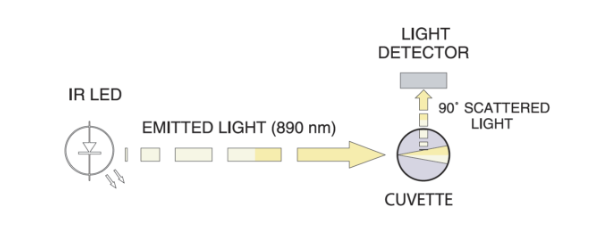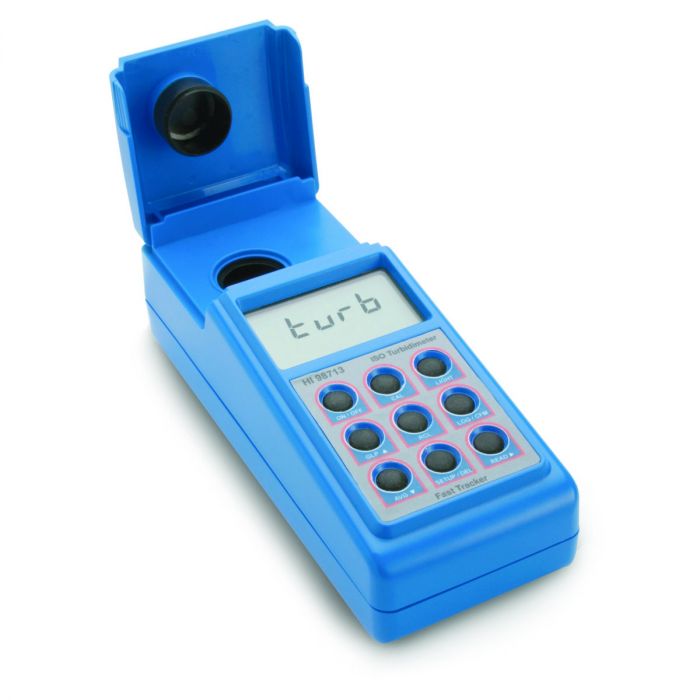ISO Portable Turbidity Meter - HI98713
The HI98713 is a high accuracy portable turbidity meter. The meter is supplied complete with AMCO-AEPA-1 primary turbidity standards used for calibration and performance verification. The HI98713 meets and exceeds the requirements of the ISO 7027 Method for turbidimetric measurements.
- USB for data transfer
- Up to four-point calibration
- Operates on batteries or line voltage
The HI98713 Precision ISO Turbidity Portable Meter is specially designed for water quality measurements, providing reliable and accurate readings, even within low turbidity ranges. The instrument is based on a state-of-the-art optical system which guarantees accurate results, assures long term stability, and minimizes stray light and color interferences. Periodic calibration with the supplied standards compensates for any variations in intensity of the LED light source. The 25 mm round cuvettes composed of special optical glass guarantee the repeatability of turbidity measurements.
Features at-a-glance
Ratio Measurement Mode
The HI98713 measures turbidity using the ratio method with a 90° and 180° light detector for more accurate measurements. Turbidity measurements can be made in the 0.00 to 1000 FNU range.
Multiple reading modes
Normal measurement, continuous measurement, or signal averaging measurement are reading modes available.
ISO Compliant
The HI98713 meets and exceeds the requirements of ISO 7027 method for turbidity measurements by use of an infrared LED light source.
Calibration
The HI98713 has a powerful calibration function that compensates for variation in light intensity. The calibration can be done using the supplied calibration solutions or user-prepared standards. A two, three, or four-point turbidity calibration can be performed by using the supplied (<0.1, 15, 100 and 750 FNU) standards. Calibration points can be modified if user-prepared standards are used.
AMCO AEPA
1 Primary Turbidity Standard - The AMCO AEPA-1 supplied standards are recognized as a primary standard by the USEPA. These non-toxic standards are made of styrene divinylbenzene polymer spheres that are uniform in size and density. The standards are reusable and stable with a long shelf life.
Fast Tracker™
For advanced field applications, the HI98713 is equipped with Fast Tracker™ - Tag Identification System (T.I.S.) that makes data collecting and management simpler than ever. Fast Tracker™ allows users to record the time and location of a specific measurement or series of measurements using iButton® tags near sampling points for quick and easy readings. Each iButton® tag contains a computer chip with a unique identication code encased in stainless steel.
GLP Data
The HI98713 features complete GLP (Good Laboratory Practice) functions that allow traceability of the calibration conditions. Data includes calibration points, date, and time.
Data Logging
Up to 200 measurements can be stored in the internal memory and recalled at any time.
Data Transfer
For further storage or analysis options, logged data can be downloaded to a Windows® compatible PC using the USB or RS232 port and the HI92000 software.
Backlit Graphic LCD Display
A graphic LCD display provides an easy to understand, user-friendly interface. All messages are in plain text making them easy to read.
Significance of Use
Turbidity is one of the most important parameters used to determine the quality of drinking water. Once considered as a mostly aesthetic characteristic of drinking water, significant evidence exists that controlling turbidity is a competent safeguard against pathogens. In natural water, turbidity measurements are taken to gauge general water quality and its compatibility in applications involving aquatic organisms. The monitoring and treatment or wastewater was once solely based on the control of turbidity. Currently, the measurement of turbidity at the end of the wastewater treatment process is necessary to verify that the values are within regulatory standards.
Turbidity of water is an optical property that causes light to be scattered and absorbed, rather than transmitted. The scattering of light that passes through a liquid is primarily caused by the suspended solids present. The higher the turbidity, the greater the amount of scattered light. Even a very pure liquid will scatter light to a certain degree, as no solution will have zero turbidity.
The ISO standard for turbidity measurement uses infrared wavelength of light that is outside the visible spectrum. The primary benefit of the ISO method over the EPA method is the reduction of color interference. The EPA method uses a tungsten lamp that produces light that contains all of the visible wavelengths of light that we see as white. A solution that is colored will be adsorbed by a complementary wavelength of light which will affect the turbidity reading. Since the ISO method is outside the visible wavelength of light the color in the sample does not interfere with the measurement. The USEPA prefers the tungsten lamp since it provides for better accuracy at low ranges and drinking water should not be colored. The requirements of an optical turbidity meter for the measurement of diffuse radiation used in low range measurements (i.e. drinking water) expressed as formazin nephelometric units (FNU) according to ISO 7027 are:
Measurement of diffuse radiation for water with low turbidity (0 FNU to 40 FNU)
- The wavelength of the incident radiation shall be 860 nm The spectral bandwidth of the incident radiation shall be less than or equal to 60 nm
- There shall be no divergence from parallelism of the incident radiation and any convergence shall not exceed 1.5°.
- The measuring angle, theta, between the optical axis of the incident radiation and that of the diffused radiation shall be 90° ±2.5°.
- The aperture angle should be between 20° and 30° in the water sample
The HI98713 meets and exceeds the meter criteria specied by ISO 7027.
Principle of Operation
The light beam that passes through the sample is scattered in all directions. The intensity and pattern of the scattered light is affected by many variables, such as wavelength of the incident light, particle size and shape, refractive index, and color. The optical system of the HI98713 includes a LED, a scattered light detector (90°) and a transmitted light detector (180°). Which detectors are used are based on the measurement mode. The lower detection limit of a turbidimeter is determined by stray light that is detected by the sensors but not caused by light scattering from suspended particles. The optical system of the HI98713 is designed to have very low stray light, providing highly accurate results for low turbidity samples.

Specifications
|
Turbidity Range |
0.00 to 9.99; 10.0 to 99.9; 100 to 1000 NTU |
|
Resolution |
0.01; 0.1; 1 FNU |
|
Accuracy |
±2% of reading plus 0.1 FNU |
|
Repeatability |
±1% of reading or 0.01 FNU, whichever is greater |
|
Stray Light |
< 0.1 FNU |
|
Calibration |
two, three, or four-point calibration |
|
Method ratio |
ratio nephelometric method (90° & 180°). Adaptation of ISO 7027 |
|
Measuring Modes |
normal, average, continuous |
|
Light Source |
860 nm infrared LED |
|
Light Dedector |
Silicon Photocell |
|
Logging Memory |
200 records |
|
Connectivity |
USB or RS232 |
|
Auto-off |
auto-off after 15 minutes of non-use |
|
Display |
60 x 90 mm backlit LCD |
|
Battery |
4 (1.5V) AA alkaline batteries |
|
Power Supply |
4 (1.5V) AA alkaline batteries or AC adapter |
|
Environment |
0 to 50°C (32 to 122°F), RH max 95% non-condensing |
|
Dimensions |
224 x 87 x 77 mm (8.8 x 3.4 x 3.0”) |
|
Weight |
512 g (18 oz.) |
|
Ordering information |
HI98713 is supplied with sample cuvettes and caps (5), HI98713-11 calibration cuvettes, silicone oil, cuvette wiping cloth, batteries, AC adapter, instructions, and rugged carrying case. |

